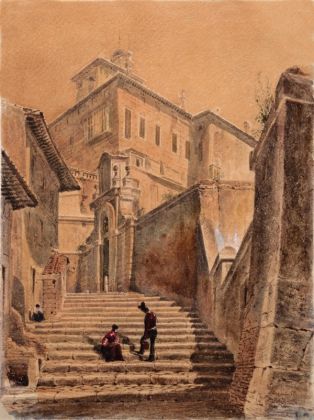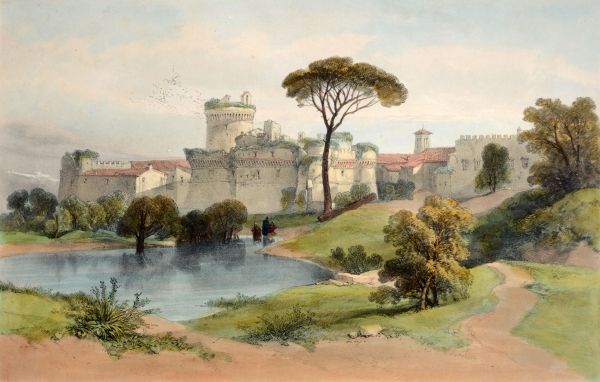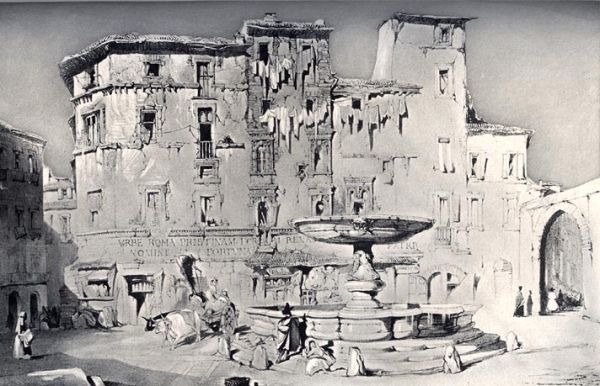Vedutisti inglesi a Roma tra il XVIII e il XIX secolo
What did Rome and its outskirts look like before photography, air travel, tarmac and the all-too-present motorcar? Museo di Roma provides a delightful answer. Two specially air-conditioned rooms lay on a Grand Tour, courtesy of the so-called vedutisti including the likes of John Ruskin, Samuel Prout and Edward Lear.
Donated from two collections (that of Baron Lemmermann and Anna Letizia Pesci Blunt) these watercolours and engravings in the museum’s collection also offer the fascination of a game of “Spot the difference”.
In Joshua Dolby’s depiction of Porta Maggiore, today’s rattling trams and fretful commuters are replaced by peasant women with paniers and giant wine-flasks being overseen by a tall-hatted gendarme.
Samuel Prout depicts a Forum filled with laundry, the pillars of this or that temple serving as a washing line. The “painter of water-colours to George IV and then Queen Victoria” was once up there with William Turner; so much so that Ruskin ventured: “Sometimes I tire of Turner, but never of Prout.” Prout’s Temple of Vespasian is proof that Ruskin was not altogether exaggerating, the picture incorporating “the truest and happiest association of sun and shade” (Ruskin again).
Even more forgotten are Edward Edwards' pictures of the Piramide with sheep grazing alongside, and then the Colosseum (1802), the building’s lower tiers still deep below ground. Here the closest anything gets to traffic is a solitary mule and muleteer.
Meanwhile courtesy of William Richardson we can watch the once mighty Tiber (1830), before it was tamed by Garibaldi's embankment. Boats are in abundance at Castel S. Angelo.
The exhibition's star, however, must be Ruskin and his two views of the Corso, drawings carrying both the precision of detail and also the light effects worthy of a painting several times the size. Another picture, of the fountain of Piazza S. Maria del Pianto, features more washing, but above massive Latin lettering. Today the fountain in the foreground is no longer there, nor is the washing, and the square has a different name – Piazza delle Cinque Scole in the Jewish quarter. Otherwise the scene is astonishingly similar.
The game of Spot the Difference extends to the city’s outskirts as well – Rome's Campagna .
Edward Lear’s views of Palazzo Farnese a Caprarola and the town couched below; a scene of peasant life before Mussolini’s famous bonifica or draining of the marshes, some oxen up to their stomach’s in mud; then a view of Sambuci where Sambuca comes from.
Thanks to William Collingwood, for whom a walk was cognate with drawing, more countryside is conserved in observant pencil; today’s instant tweets and snapshots are another century’s slow and painstaking sketching, landscape lovingly lingered over for hours, even days.
Exhibition completed, it is worth crossing the forecourt and climbing the grand Valadier stairway to view another British master. Opposite a portrait of Piranesi, is a work by another artist much sought after by Grand Tourists, Joshua Reynolds. In his painting Catherine Bishop the background may be London, the spaniel archetypically English, but the figure of the girl is a variation on the ancient statue of “Girl with a dove” then in the Capitoline Museums.
Museo di Roma Palazzo Braschi, Via di S. Pantaleo 10, tel. 060608, www.museodiroma.it
Review by Martin Bennett



























